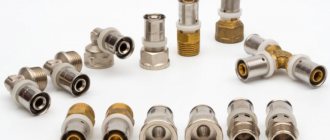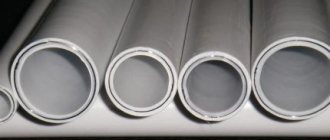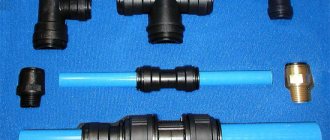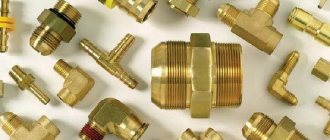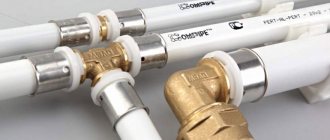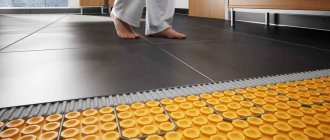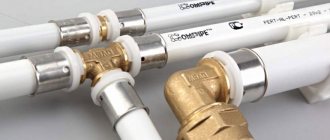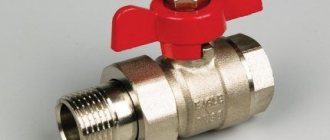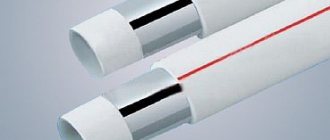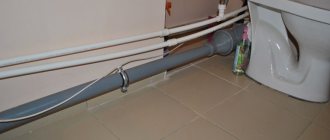Due to their high physical characteristics, metal-plastic pipelines have found wide application in various areas of household services. One of their main distinguishing features is that the installation of metal-plastic pipes is accessible to both specialists and ordinary users without special tools.
In order to lay a pipeline line with the help of hired workers, and even more so independently, it is useful to study the basic physical characteristics, as well as the dimensional parameters of plastic pipes. To install a metal-plastic pipeline, you should know the existing installation methods and the tools used for this.
Rice. 1 Pipes made of cross-linked PEX and heat-resistant PE-RT polyethylene - structure and appearance
Types of fittings for metal-plastic pipes
The peculiarity of MP products is that they can be connected only with fittings of different configurations.
There are several types of them :
- Collet - detachable designs, used repeatedly. The threads on the parts are suitable for matching with household appliances. In addition to the brass body, it contains crimp rings and rubber gaskets.
- Compression parts are conditionally detachable and can be easily dismantled, but reuse does not guarantee tightness. There are o-rings and gaskets, and union nuts are used for clamping.
- Push fittings are easy to install and do not require special tools. Used for detachable connections. The pipe is inserted into the part and clamped with a ring with claws. It is intended only for products with exact wall thickness; if it differs even slightly, the connection is unreliable.
- Press fittings - form permanent connections. Fixation occurs using press pliers.
According to the configuration, the following fittings are distinguished:
- adapters - connect products of different diameters;
- tees - used to connect branches;
- corners - change direction;
- crosspieces - for connecting 4 pipes;
- water sockets - with a mount for connecting a mixer.
Pipe line marking
Before starting work on laying a pipeline, you need to know exactly how the pipes will be placed. A diagram should be developed:
Draw lines of pipes on the walls of the room to visualize the entire structure.
You should install as few tees, fittings and crosses as possible, because they will affect the pressure force.
When laying corners, you need to use a pipe bender or corner fittings.
Free access to all connecting parts must be ensured.
The connecting parts should be installed after completing the calculations and markings.
Fittings for metal-plastic systems
When starting to work, the first thing you should do is cut the pipes into sections of the required length. It is important to make cuts only at right angles to avoid defects. When the pipe does become deformed during cutting, it should be leveled with a gauge.
To connect pipes of different categories into a coherent structure, special elements are used - fittings, which differ in type of design, size and methods of fastening. The most common:
- adapters for connecting pipes with different diameters;
- tees;
- corners that change the direction of water flow;
- water sockets;
- crosses.
Preparation for installation
A drawing is made in advance and the dimensions are indicated. Connecting elements are drawn on the branches and their parameters are written. Keep in mind that fittings for taps must have a thread at the end. They make a list and make purchases based on it - there is no point in purchasing expensive, redundant or unnecessary products. Pipes are purchased with a small reserve.
Tools
Before installation, metal-plastic blanks are cut at right angles. The most convenient way is to use a special cutter that looks like scissors. It forms the desired cutting angle - 90°. Can be replaced with a hacksaw and cut in a carpenter's miter box.
In addition, other tools are used:
- Calibrator. The main purpose of the tool is to restore the original shape of metal-plastic and align the edges. The ends are flattened after cutting, which complicates installation. It also serves to flare the pipe outward, which is necessary for installation.
- A countersink is a device used to remove chamfers and burrs, but if not available, clean it with sandpaper or a construction knife. Some calibrators are equipped with a special protrusion for chamfering, so they do without a countersink.
- Pliers - necessary for installing non-separable fittings.
For work you will also need adjustable wrenches, a hammer, and a screwdriver.
Preparation procedure
Preparation of metal-plastic pipes for installation.
Pipes are bought rolled into a ring. When starting installation, cut pieces of the required length, adding up to 15 mm to fit into the fittings. When using a saw, burrs remain on the edges, which are removed (they are gone after the cutter).
If a countersink is used, the outside is chamfered at the same time. Then the calibrator is driven into the cavity and turned. At the same time, the geometry is leveled and the edge is flared.
Remove the internal chamfer using a construction knife if the tool is without a special device.
How to level a piece of metal-plastic pipe
They first straighten it with their hands, but the perfect shape is not obtained - this is important for the open installation method. Use a simple device. Find a flat surface and wrap the piece in cloth. Roll it over the board to create an even piece.
Tools and materials for laying pipes
When laying a metal-plastic system with your own hands, without the help of specialists, you will need a minimum number of tools and materials that are sold in construction stores. But you should choose only high-quality products.
Pipeline installation accessories
When carrying out construction work with metal-plastic structures, you will need a very small set of tools:
- scissors that are designed for cutting pipes;
- chamfer and calibrator;
- roulette;
- drill;
- valves;
- fittings and press
for them; - pipe cutter
- pipe bender;
- sliding and ring wrenches
.
What materials will be needed
When laying a pipeline in the house you will need the following materials:
- pipes (coils, measured sections);
- different fittings - with their help, individual sections will be turned into a whole system;
- fastening elements - various clips and clamps, on which the structure will be fixed;
You should stock up on all the tools and materials in advance so that during work you will not be distracted by purchasing missing items, which will significantly slow down the repair process.
Wiring diagrams for bathrooms and bathrooms
Wiring is carried out in several ways. It is important for everyone to stick to the minimum number of connections. It is advisable to purchase pipes and fittings from one manufacturer - installation will go faster. It is necessary to provide access to connectors and valves.
Efficient collector system
Collector system diagram.
Each consumer is connected to the central highway separately. A collector is used, which is hidden in a small closet.
Shut-off valves are installed on branches to all devices. This allows you to regulate the water supply or turn it off completely, which is convenient if you need to replace or repair a plumbing fixture. It is turned off, the remaining consumers work. The pressure on all branches is the same.
The supply pipes use a minimum number of fittings.
Manifold wiring can be used for hidden installation. Only the fittings protrude outside and can be serviced if necessary. The pipelines in the wall are solid.
The only drawback is the high cost. More pipes and shut-off valves are required per branch. The diagram is complex - it must be carefully thought out, drawn, and installation must be carried out carefully. Used with a large number of plumbing equipment.
Serial connection system
A central main line is laid, to which consumers are connected individually through tees. This option is more suitable for bathrooms with a minimum number of appliances. It is used mainly for open installation; it can be done even after finishing the room. Financial costs are minimal - fewer pipes and taps are required compared to a collector circuit. The main expenses are for tees.
A significant drawback is that there may not be enough water pressure if several points are working at the same time. If one device breaks down, all devices must be disconnected for repair.
Wiring system with pass-through sockets
The circuit is similar to the sequential one, but without the tees. Instead, water sockets are used, through which devices are connected. Used in private homes - long pipelines and an additional pump are required to increase the pressure. The connection is quick-release.
The circuit is sequential, but without tees.
Layout of sewer pipes
There are installation specifics:
- do not use 90° elbow fittings;
- install tees with inspection covers in places of possible blockages;
- for hidden installation, viewing windows are left in front of them in the wall;
- make a reserve for thermal expansion.
Use pipes with a diameter that allows wastewater to easily pass through. For the toilet - 100 mm, for other appliances - 50 mm. Maintain a slope towards the drain. For 100 mm products it is 2 cm per 1 linear line. m, for 50 mm - 3 cm, respectively.
Connection diagrams
When deciding how to connect metal-plastic pipes, you should take into account the fact that pipelines from such products are installed according to two main schemes.
Sequential
This scheme implies that all elements of the pipeline system are connected to each other in series - from one point of consumption to all subsequent ones.
Scheme of sequential pipe distribution in an apartment
Collector
When using this connection diagram, a separate pipe supply is installed for each of the consumption points. The manifold pipeline installation scheme is considered more convenient to use and economical.
An example of manifold wiring for a heating system
Almost any scheme of a plumbing system, installed including using metal-plastic pipe products, includes the following elements:
- taps, which use products capable of withstanding pressure up to 60 atm and operating at temperatures up to +150˚;
- a coarse filter, which is installed on the pipeline section behind the inlet tap (the task of the filter is to protect the water supply system from the ingress of various contaminants, such as sand, scale, etc.);
- a device used to record water consumption;
- a filter that provides finer purification of the water entering the system;
- pressure reducer;
- directly the collector itself, from which water pipes are diverted to each of the points of consumption (thanks to the collector in water supply systems, water is supplied to each of the points of consumption at the same pressure).
Installation of metal-plastic pipes using compression fittings
The most common and simple connection for self-installation of water supply from metal-plastic pipes. You will need 2 wrenches for the union nuts. The connection can be easily replaced if necessary. The parts, despite the variety of configurations, are of the same type in design. They consist of a cast body with threads, ferrules for securing the pipe and union nuts. Tightness is ensured by sealing rings.
Using compression fittings, installation of metal-plastic pipes.
Sequence of work:
- Unscrew the fitting and disassemble it. Make sure that the rubber seals are present. Assemble: the nut, then the ring is put on the pipe.
- The calibrator is inserted and the pipe is flared. The inside and the shank of the fitting with the gasket are lubricated with a soap solution. These measures make installation easier and the gaskets do not move or tear.
- The fitting is inserted until it stops, and the ring is moved. Tighten the nut using 2 wrenches.
The last operation requires some skill. If you don't tighten it enough, a leak will occur; if you overdo it, the fragile nut will burst. You should stop the moment you hear a slight crunch. The connection is periodically inspected and the nuts are tightened if a leak occurs.
Three main methods of pipe routing
There are several ways to make wiring for modern types of metal-plastic pipes. When choosing the appropriate option, you should take into account rationality and the possibility of gaining access to the system during further operation.
Read more about metal-plastic pipes in the article - Metal-plastic pipelines
Hidden
With this system, pipes and connections are hidden in the walls under external finishing materials. Only fittings and bends that will be used to connect plumbing are brought to the surface. This method involves installing a water supply system and its entire structure in the walls, where niches for pipes have been prepared in advance. After installation is complete, the surface is sealed.
The hidden system allows you to preserve the interior design, which is important. Also, this installation option will protect the pipes from unwanted damage.
However, this method also has its drawbacks. When laying, you need to groove the surface, and after installing the system, restore everything again. This method is completely unsuitable for load-bearing walls, because their violation is prohibited and is unsafe for the entire structure of the building. We should not forget about the costs associated with additional work.
Open
When it is not possible to hide pipes in the walls, they are laid on the surface. This method is convenient because you can visually monitor the condition of the entire system and its connections, and if a problem arises, you can quickly clean the area or replace individual components.
The pipes are laid along the surface of the walls, which allows you to control the joints and significantly reduce the final cost of the entire work.
This option is suitable for premises in which repairs have already been made, but for some reason the pipes have not been installed. Among the advantages of an open wiring system, ease of installation and lower cost compared to the previous wiring option should be noted.
Combined
Perhaps the combined wiring system is currently the most popular way to install communications. The pipes are laid along the walls, then covered with a box made of plasterboard, tiles or false panels. This method is very difficult, because you need to perfectly calculate how such elements will fit into the interior.
Installation of crimping presses or push fittings on MP pipes
Preparation of the cut is similar, but the chamfer from the outside is not removed, only the inside is made. Before installation, dismantle the sleeve and inspect the part to exclude the use of defective elements. They put it back together, not forgetting to install a special gasket to protect against corrosion processes.
The segment is placed on the fitting. The seating depth is visible through the window in the sleeve - the edge of the pipe should be visible. Pliers with pads of the required diameter are installed on the edge of the fitting. The handles are connected by crimping the part. If everything is done correctly, 2 clear stripes of equal depth will form.
Connecting metal-plastic pipes with your own hands if you follow the technology turns out to be reliable, communication can be confidently hidden in walls or concrete screed. The product is disposable and cannot be taken apart. The technology is used primarily for heating systems - the connection can withstand 10 atm. It is not recommended to use above the 16th floor - the pressure may be higher.
Push fitting components.
A push fitting is a part whose creators sought to do without special pliers during installation. The clamping is carried out by a ring, otherwise the design is similar to a press fitting.
The prepared section is pressed onto the fitting; a click indicates the correct connection. You can make sure by pulling the parts in different directions.
The pipe rotates after connection, so there are doubts about the reliability of the fastening, but this is not the case. Experts still do not recommend installing push fittings for structures in a wall or concrete screed.
The parts are expensive, so they are not widely used. The connection occurs quickly, but the structure can only be used after 3 hours. This is the time during which the seal takes a shape that best matches the contours of the pipe.
Operational and physical features of metal-plastic pipes
Plastic pipes have the following features:
- They are environmentally friendly, the share of volatile substances in metal-plastic according to GOST does not exceed 0.035%.
- The material is non-corrosive and chemically neutral.
- Thanks to the smooth inner surface, limescale, rust, and dirt are not deposited on the walls.
- In the manufacture of pipes, polyethylene with a degree of cross-linking of at least 60% is used.
- A distinctive feature of metal plastic is its strictly fixed wall thickness of 2, 3, 4, 5 mm.
- Pipes are produced in coils with a length of 50 to 200 m. Their dimensions, according to GOST, are determined by the outer diameter and consist of the following number series: 16, 18, 20, 26, 32, 40, 50, 60 mm. It is worth noting that this series does not coincide with the standard 16, 20, 25, 32, 40, 50, 63 due to the fact that between standard sizes a fixed wall thickness of 2, 3, 4, 5 mm is maintained.
- Thanks to the aluminum shell, the products are gas-tight, which allows them to be widely used in systems with metal components (connecting boilers, pumping equipment, fittings, wiring of panel radiators).
Rice. 3 Press fittings for metal-plastic pipes
Article on the topic:
What are the types of fittings for metal-plastic pipes, installation features. The article describes options for connecting metal-plastic pipes, types of fittings, an overview of leading manufacturers and installation instructions.
- According to GOST, the service life of metal-plastic pipelines should not fall below 50 years if it is used in cold water supply lines.
- Pipes for water supply transporting hot water or used in heating systems must last at least 25 years.
- Like all polymers, metal-plastic pipes have low thermal conductivity of about 0.43 W/m °C and are capable of absorbing noise.
- Capable of withstanding pressure when used in networks with a cold working fluid up to 25 bar, when working in a hot environment 10 - 12 bar.
- The maximum operating temperature at which metal-plastic products can be operated is 95 °C.
- Thanks to the smooth shiny surface they have an aesthetic appearance.
- Rigid metal-plastic pipes are bent using special pipe benders made of metal spirals.
- The disadvantages of metal-plastics include their poor resistance to ultraviolet radiation.
- During installation, a metal-plastic pipeline, due to its rigidity, can be irreversibly damaged by physical impact on the shell.
- The main disadvantage of all pipe products with aluminum shells is the likelihood of their delamination due to the difference in the thermal linear expansion of aluminum and polyethylene.
Rice. 4 Application of plastic pipes
How to bend a metal-plastic pipe
Several methods are used, among which manual ones are most often used at home. The simplest and least reliable is using only a hair dryer. The method is suitable for products with a diameter of no more than 20 mm; thicker ones are difficult to bend. The pipe is heated with a hairdryer and clasped with your hands so that your thumbs serve as stops. Bend gradually in several stages.
Sudden movements are unacceptable, otherwise the product may be deformed. The maximum bending radius, which is indicated in the technical characteristics of the products, should not be exceeded. Pre-train on small scraps.
Using a spring allows you to achieve high-quality and precise bending. It is necessary to select a strong spring of suitable diameter so that it fits into the pipe with a small gap. A wire is attached to one end to pull the part out when the work is completed. Insert inside, placing the middle in the center of the bend. The bend, resting on the knee, can be heated with a hairdryer. The method is used for metal-plastic of medium and low hardness.
Methods on how to bend a metal-plastic pipe.
Another method is to use stiff wire. It is cut into small pieces, filling the internal space at the bend. The further process is similar to the version with a spring. After use, the wire is removed. The method takes more time, but is effective.
Bending metal-plastic with sand is the most labor-intensive process. The internal cavity is filled with fine sifted sand, leaving no voids. Both ends are muffled.
Heat it up and begin to gradually bend it. Salt is also used instead of sand. In both cases, the pipe is thoroughly washed at the end of the work.
The most perfect option is to use a pipe bender. There is no need for heating, and the bending radius reaches 180°, eliminating defects. The design of the device is simple, it consists of 2 rollers - a movable one and a template, and a bracket handle.
You can make an analogue yourself if you don’t have a pipe bender. A semicircular template with the radius required for bending is cut out of a board whose thickness exceeds the diameter of the pipe. Firmly fixed to the base - the product is ready for use.
Prices for materials and services
The average price for installing a metal-plastic pipeline starts from 3,000 rubles. Naturally, the cost of materials is not included in this amount. The final price is determined depending on the volume and complexity of the work, installation methods and associated costs. A linear meter of metal-polymer pipe with a diameter of 16 mm costs an average of 75 rubles, with a diameter of 26 mm - 185 rubles. The price for fittings is from 109 to 300 rubles.
The right approach to installation and high-quality materials will help create a durable system that will serve for a long time without leaks, repairs and unnecessary financial costs.
How to attach to walls
With the open installation method, the pipes are fixed to the wall. An affordable and attractive option is to use plastic clips. They are of different sizes, buy them according to the diameter of metal-plastic products. They are single - suitable for laying water supply lines. Double clips are appropriate to use for a two-pipe heating system. The supply and return lines are located side by side and parallel.
The distance between the clips is 1 m, but you can do it more often, then the pipes will definitely not sag. Holes are drilled in the walls for fastening and secured with self-tapping screws and dowels. Screws are screwed into a wooden wall without dowels. In places of turns, clips are installed on both sides closer to the bends.
Plastic clips for fixing the pipe to the wall.
Advantages and disadvantages of metal-plastic water supply
There are several objective indicators that allow metal-plastic pipes to outshine their competitors when installing a water supply system in an apartment or house:
- Easy to install. If the work is carried out carefully, it can be performed by anyone without any preparation. In practice, this is something like a construction set, the assembly of which does not require expensive tools or special skills.
- Reliability. The 50-year guarantee is proof of this. But note that this applies to pipes, not their connections.
- Price. One thing can be said: “Cheaper, but for nothing.” Polypropylene pipes can compete in some way in this parameter, but in other respects they lose.
Based on the above, water supply using metal-plastic pipes is reliable, inexpensive, and you can assemble it yourself. Naturally, connecting to the central system is the prerogative of professionals.
Sadly, every barrel of honey also has its own fly in the ointment . In the case of metal-plastic water supply, these are fittings.
A fitting is a device with which you can:
- change direction;
- drown out;
- connect;
- branch.
In our case we are talking about metal-plastic pipes. If the fitting has the same diameter at both ends, then it is straight; and if different, then transitional.
But these are only their varieties according to their intended purpose, but according to the method of fixation, all fittings are divided into crimp and press fittings.
- Compression fittings. Otherwise called ring-shaped, or serviced. In these, fixation is carried out due to the conical shape, internal surface, crimp nut, which, when tightened, compresses the cutting ring. Such connections can be disassembled and require periodic maintenance. Usually once a year, the compression fittings on metal-plastic pipes through which hot water should be checked and, if necessary, tightened slightly. The reason for their weakening is temperature deformation from hot water. For their installation, two gas (adjustable) wrenches are required.
- Press fittings. Or maintenance-free, they are fixed on the pipe by pressing in a special crimp sleeve. The work is carried out using press tongs. They can be manual or electric. The first ones cost from 4 tr., the second ones from 25 tr. The connection turns out to be permanent, but with a guarantee against leaks, regardless of the water temperature. Most often, press fittings are used in connections that will be walled into walls, or with difficult access after repairs.
The reliability and quality of connections depend on the scrupulous execution of instructions. But for the price... Although press fittings are cheaper than crimp fittings, their total cost for installing water supply in an apartment is equal to the cost of metal-plastic pipes.
Non-standard connections with metal pipes, transition to a different diameter
Repairing a water supply or heating system, if steel pipes were previously used, requires connecting metal and metal-plastic together. The metal pipe is cut, leaving 3-5 cm, and an external thread is made. The connection must be sealed. Wrap it in tow, smear paint or use fum tape.
A fitting that has a union nut or internal thread is screwed onto a metal pipe. Metal-plastic is fixed on the reverse side. The products are connected, the nut is tightened.
If the pipelines are of different diameters, installation is carried out in the same way. Just select an adapter fitting that has the appropriate dimensions. On one side there is a connector for metal-plastic, on the other there is a thread for a steel pipe.
Press fittings for pipeline connection
Press fittings are installed on pipes and form a one-piece, non-separable structure. They can be crimp or tension. The connection of tension fittings is carried out using special hydraulic press machines. This type of fastening is susceptible to exposure to negative temperatures, so it can only be used indoors. Press connection adapters come in the following types:
- Couplings;
- Squares;
- Transitional tee with fastening.
Components for a rigid crimp connection consist of the following elements:
- Fitting;
- Crimp coupling;
- Dielectric gasket.
Press fittings
Crimping the coupling around the pipe ensures a secure connection. The coupling itself can be made of brass or steel.
How to repair
Before you begin repairing a metal-plastic pipe, you need to determine the location of the leak, turn off the water supply and dry the pipe, as well as clean it of grease, dust and other contaminants.
Repairs can be carried out using one of the following technologies:
- Bandage as a temporary repair method. You need to take a rubber pad, apply it to the leak area and secure it.
- Temporary methods also include a flange into which a rubber gasket is installed.
- Using sealant, you can reliably seal cracks and leaks, but this composition will also deteriorate over time.
- Epoxy glue - the leak area is coated with it, then a layer of bandage or cotton fabric is applied, after which another layer of glue is applied. The entire area must dry for 11 hours, and then the water supply can be restored.
Most often, repairs are made at the joints, that is, at the fittings. You can simply tighten the junction of the elements, but if the leak does not stop, then the joint will have to be dismantled. Here the possible causes of malfunctions are:
- damage to the rubber sealing rings - such elements are not repaired, but replaced;
- if the pipe has an uneven cut, then it needs to be leveled and recalibrated;
- If the brass body of the fitting bursts, the fitting is completely replaced.
When installing new fittings, you can lubricate the joints with silicone - this provides additional waterproofing.
Features of installation using press fittings
Such products are more reliable and durable (service life is at least 50 years), withstand operating pressures of up to 10 bar and ensure ease of installation.
The only drawback is the need to use a special pressing machine, manual or hydraulic with a microprocessor.
Assembly order:
- Cut a piece of pipe to the required length.
- Chamfer the ends and adjust the diameter of the product.
- A sleeve made of stainless steel is placed on the end.
- Insert the prepared part of the pipe into the fitting until it stops.
- Using the grip of the press machine, the sleeve is compressed, bringing the handles of the press together.
